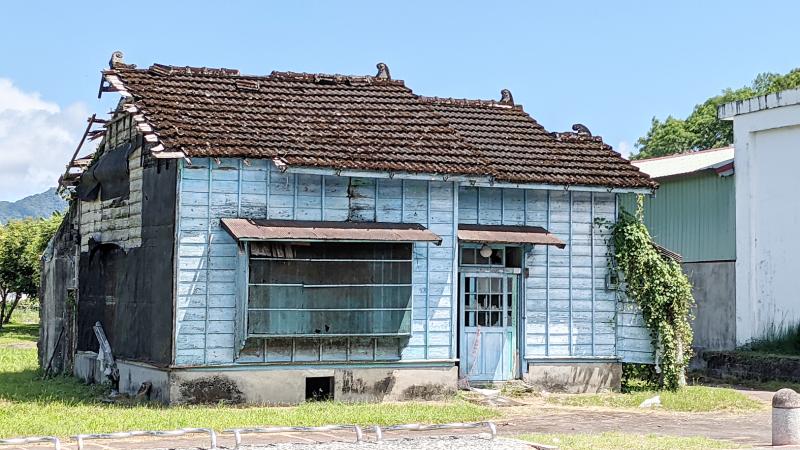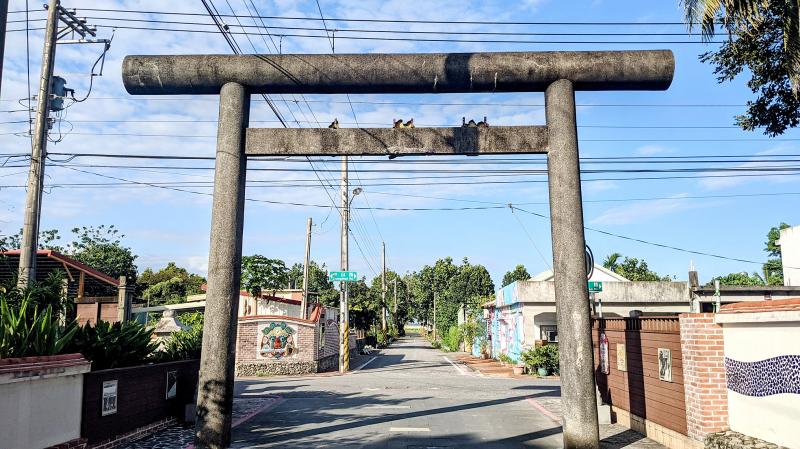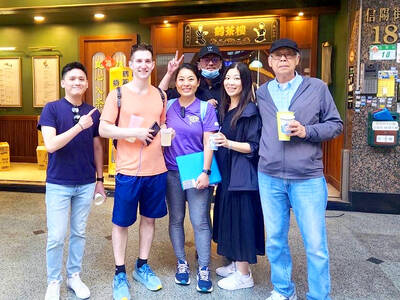All that’s left of the Yoshino Shinto Shrine are a stele and the ruined bases of three stone lanterns. In place now is an arts village promoting Hakka and Aboriginal culture, a wet market and the Qingfeng City God Temple (慶豐城隍廟), which was established in 2005.
The overlay of cultures underscores the tempestuous history of this part of Jian Township (吉安) in Hualien County, which saw the removal of the original Amis inhabitants after the Cikasuan Incident of 1908 and the establishment of Taiwan’s first government-sponsored Japanese immigrant village of Yoshino in 1910. The Chinese Nationalist Party (KMT) destroyed the shrine in its bid to rid Taiwan of Japanese influence, but they preserved the large stele commemorating the founding of Yoshino, which sits quietly under a colossal camphor tree estimated to be 200 years old.
Located just a 15-minute drive from Hualien Railway Station, these ruins are a good place to start exploring this chapter of Taiwanese history. On the surface, Jian is just another rural East coast township with drab streets criss-crossing lush farmland, but one can spot crumbling Japanese-style houses here and there as well as the popular Buddhist Yoshino Shrine (吉安慶修院), which was spared destruction due to the KMT’s affinity to the religion.

Photo: Han Cheung, Taipei Times
Encouraged by the success of Yoshino, two other immigrant villages were established to the south: Toyota in 1913 and Hayashida in 1914. Both are now in mostly Hakka areas and are easily accessible by train, and I spent a few weekends exploring the remnants of colonialism that still dot the sleepy landscape a century later. Note that most of the sites are not very well maintained, and will definitely appeal more to those interested in history and culture rather than selfie-seekers.
SLOW COUNTRY
The area’s history of conflict against outsiders dates back to the 1850s, when the first Han Taiwanese settlers arrived in Hualien. The local Cikasuan Amis aborigines sided with the Qing Dynasty during the Takobowan Incident of 1878 against the Sakizaya and Kavalan peoples, after which they became the dominant regional power.

Photo: Han Cheung, Taipei Times
The Japanese employed the Cikasuan Amis to guard the defense lines against the hostile Truku people in the mountains. Like the Qing, they often exploited historical animosities between Aboriginal groups to better control them. However, they did not treat the Cikasuan Amis well and often underpaid them, leading to an uprising after which they were forcefully relocated.
This incident is marked by a towering monument by the Cikasuan River, erected by the Jian Township office in 2012. With the Amis gone, the Japanese recruited immigrants from Shikoku island to farm the land, and by 1919, there were over 300 households living in Yoshino, which was a self-contained settlement with schools, a hospital, and facilities for both Shinto and Buddhist followers.
I was roughly aware of this history when I decided on a weekend trip to Fenglin Township (鳳林), where Hayashida was located. But I was mostly drawn to the town due to its being one of four locales in Taiwan certified by Italy-based Cittaslow International, and the astonishing views of the valley we could see from our guesthouse halfway up the mountains.

Photo: Han Cheung, Taipei Times
Snail sculptures, paintings and motifs are seen all over town to promote its slow living, slow eating ethos. Yet everything seems a bit faded and neglected — the COVID-19 pandemic definitely played a part. The population is aging, evidenced from the abundance of elderly facilities in the town, a problem common with most rural communities. Still, there’s enough to keep the visitor busy (at a leisurely pace) for a day or two and it’s also a popular base to explore the region.
Remnants from the Japanese days include an intact police station, a dilapidated teacher’s dormitory and the ruins of a similarly-demolished Shinto shrine. But what stands out are the numerous tobacco barns scattered throughout the fields. The Japanese designated the area for tobacco growing, and the distinct two-story structures were used to cure the leaves.
Unfortunately, most of these barns are in falling apart, unless they’ve been converted for other purposes such as guesthouses. The saddest fate is that of the Hsu Chia-hsing Tobacco Barn (徐家興菸樓), which was given a tasteless European-style makeover in the 1990s and is now completely gutted and home to a family of dogs. The mother is quite protective, so be careful when you approach. Although most of the barns are closed to the public, I made a game out of spotting them while cycling through the picturesque green fields. I counted eight in about two hours.

Photo: Han Cheung, Taipei Times
HAKKA AND JAPANESE
The modern townships that the three immigrant villages are located in are predominantly Hakka. According to the Hakka Cultural Museum in Fenglin, the Japanese recruited them from the west coast in several waves to help work the land since there were not enough Japanese immigrants.
Hakka culture is very pronounced In Fenglin, where we enjoy a delicious meal at the fixed-menu restaurant Si Dai Wu Nong (四代務農, “four generations of farmers”). It can be found at 1, Dajhong Road, Fenglin Township, Hualien County (花蓮縣鳳林鎮大忠路1號), tel: 0921-750866.

Photo: Han Cheung, Taipei Times
The Fenglin Hakka museum (鳳林客家文物館) is a bit run down but very informative (information in English and Chinese) about Hakka history on the east coast, and is worth a peek if you have time. The ubiquitous snails remind visitors to take things at a leisurely pace, and soak in the atmosphere of this sleepy town that’s not exactly pretty but has a charming atmosphere of days gone by.
If you think Fenglin is slow, however, try visiting Fengtian (豐田), about 13km to the north. Come here on a weekday and the streets are mostly deserted, with more activity going on in the colorful murals depicting rural and Hakka life that can be seen throughout town.
The remnants of Toyota Village (same Chinese characters as Fengtian) are located about 15 to 20 minutes from the train station. Visitors will first see the torii gate leading to the former Shinto shrine, with a “Bilian Temple” (碧蓮寺) sign tacked onto it. It was converted into a Buddhist temple after World War II, and the erasure of colonial elements is also apparent with the Japanese writing crudely scratched off the stone lanterns at the entrance.

Photo: Han Cheung, Taipei Times
The KMT did not smash this structure; it was destroyed by Typhoon Winnie in 1958, and a folk temple was built in its place about a decade later. The Japanese residents of these villages — many of whom were born in Taiwan — were sent back to Japan after the war, but still kept ties with their Taiwanese hometowns. Near the temple door is a list marking a 1979 donation by members of the Toyota Association (豐田會), which was made up of such people.
After the Japanese left, many Hakka moved into their houses and renovated the interior while keeping the exterior intact. The roadside murals in this part of town pay tribute to this dual heritage, alternating depictions of Hakka culture with black-and-white photos from the Japanese colonial era.
Today’s Fengli Elementary School (豐裡國小), which was established for Japanese children in 1913, contains many structures, relics and old photos of those days as well as numerous displays devoted to this history. For food, we dined at Hetianye (禾田野), an attractive cafe housed in a 80-year-old Japanese building that housed the local Taiwan Sugar plant manager after World War II. 2, lane 121, Jhongshan Road, Shoufeng Township, Hualien County (花蓮縣壽豐鄉中山路121巷2號), tel: (03) 865-3710.

Photo: Han Cheung, Taipei Times
The rise and fall of the nation’s sugar industry is also an intriguing part of local lore, but there was no time to look into it. What I did was just a cursory exploration into one aspect of the area’s layered past, and there’s a lot more to dig into on future visits.
GETTING THERE:
Yoshino, Toyota and Hayashida are easily accessible from their respective train stations of Hualien/Jian, Fengtian and Fenglin. Bikes can be rented in Fenglin for NT$150 a day, call (03) 876-1605 to check for availability. Call 0933-537-793 for bike rentals in Jian, the shop is near the Yoshino Shrine, also NT$150 a day. Fengtian is easily explored on foot.

A vaccine to fight dementia? It turns out there may already be one — shots that prevent painful shingles also appear to protect aging brains. A new study found shingles vaccination cut older adults’ risk of developing dementia over the next seven years by 20 percent. The research, published Wednesday in the journal Nature, is part of growing understanding about how many factors influence brain health as we age — and what we can do about it. “It’s a very robust finding,” said lead researcher Pascal Geldsetzer of Stanford University. And “women seem to benefit more,” important as they’re at higher risk of

Eric Finkelstein is a world record junkie. The American’s Guinness World Records include the largest flag mosaic made from table tennis balls, the longest table tennis serve and eating at the most Michelin-starred restaurants in 24 hours in New York. Many would probably share the opinion of Finkelstein’s sister when talking about his records: “You’re a lunatic.” But that’s not stopping him from his next big feat, and this time he is teaming up with his wife, Taiwanese native Jackie Cheng (鄭佳祺): visit and purchase a

April 7 to April 13 After spending over two years with the Republic of China (ROC) Army, A-Mei (阿美) boarded a ship in April 1947 bound for Taiwan. But instead of walking on board with his comrades, his roughly 5-tonne body was lifted using a cargo net. He wasn’t the only elephant; A-Lan (阿蘭) and A-Pei (阿沛) were also on board. The trio had been through hell since they’d been captured by the Japanese Army in Myanmar to transport supplies during World War II. The pachyderms were seized by the ROC New 1st Army’s 30th Division in January 1945, serving

Mother Nature gives and Mother Nature takes away. When it comes to scenic beauty, Hualien was dealt a winning hand. But one year ago today, a 7.2-magnitude earthquake wrecked the county’s number-one tourist attraction, Taroko Gorge in Taroko National Park. Then, in the second half of last year, two typhoons inflicted further damage and disruption. Not surprisingly, for Hualien’s tourist-focused businesses, the twelve months since the earthquake have been more than dismal. Among those who experienced a precipitous drop in customer count are Sofia Chiu (邱心怡) and Monica Lin (林宸伶), co-founders of Karenko Kitchen, which they describe as a space where they